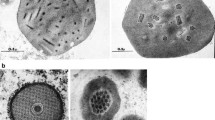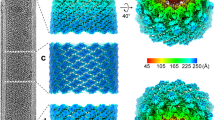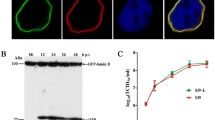Abstract
The baculovirus P10 protein has always represented a mystery in the field of insect virology. Like the baculovirus polyhedrin protein it is expressed at high levels very late in infection. Homologues of the Autographa californica nucleopolyhedrovirus p10 gene are conserved in all Alphabaculoviruses and in other viruses of lepidopteran hosts yet is completely dispensable for virus replication and transmission. P10 is a microtubule interacting protein whose expression has been associated with the formation of a variety of complex and extensive cytoplasmic and nuclear structures. P10 has been associated with a number of roles during infection ranging from the formation of virus occlusion bodies, to affecting the rate of cellular and/or nuclear lysis during the final stages of the virus replication cycle. In this article we review recent work aimed at understanding the role of this enigmatic protein, putting them into context with recent advances in understanding of protein structure and function. We look back at a number of historical studies and observations, reanalysing their conclusions based on recent data and our own observations. The role of the P10 protein during baculovirus replication remains elusive, however, novel avenues of investigation have been identified that will, we are sure, eventually lead to an understanding of this protein.
Similar content being viewed by others
References
Adang M J, Miller L K. 1982. Molecular cloning of DNA complementary to mRNA of the baculovirus Autographa californica nuclear polyhedrosis virus: location and gene products of RNA transcripts found late in infection. J Virol, 44(3): 782–793.
Alaoui-Ismaili M H, Richardson C D. 1996. Identification and characterization of a filament-associated protein encoded by Amsacta moorei entomopoxvirus. J Virol, 70(5): 2697–2705.
Alaoui-Ismaili M H, Richardson C D. 1998. Insect virus proteins (FALPE and p10) self-associate to form filaments in infected cells. J Virol, 72(3): 2213–2223.
Bonner W M. 1975. Protein migration into nuclei. I. Frog oocyte nuclei in vivo accumulate microinjected histones, allow entry to small proteins, and exclude large proteins. J Cell Biol, 64(2): 421–430.
Brown J H, Cohen C, Parry D A. 1996. Heptad breaks in alpha-helical coiled coils: stutters and stammers. Proteins, 26(2): 134–145.
Carpentier D C, Griffiths C M, King L A. 2008. The baculovirus P10 protein of Autographa californica nucleopolyhedrovirus forms two distinct cytoskeletal-like structures and associates with polyhedral occlusion bodies during infection. Virology, 371(2): 278–291.
Chaabihi H, Ogliastro M H, Martin M, et al. 1993. Competition between baculovirus polyhedrin and p10 gene expression during infection of insect cells. J Virol, 67(5): 2664–2671.
Chang D K, Cheng S F, Trivedi V D, et al. 1999. Proline affects oligomerization of a coiled coil by inducing a kink in a long helix. J Struct Biol, 128(3): 270–279.
Cheley S, Kosik K S, Paskevich P, et al. 1992. Phosphorylated baculovirus p10 is a heat-stable microtubuleassociated protein associated with process formation in Sf9 cells. J Cell Sci, 102(Pt 4): 739–752.
Chothia C, Levitt M, Richardson D. 1981. Helix to helix packing in proteins. J Mol Biol, 145(1): 215–250.
Chung K L, Brown M, Faulkner P. 1980. Studies on the morphogenesis of polyhedral inclusion bodies of a baculovirus autographa californica NPV. J Gen Virol, 46: 335–347.
Cohen C, Parry D A. 1994. Alpha-helical coiled coils: more facts and better predictions. Science, 263(5146): 488–489.
Crick F H C. 1952. Is alpha-keratin a coiled coil? Nature, 170(4334): 882–883.
Crick F H C. 1953. The packing of alpha-helices: Simple coiled-coils. Acta Crystallogr, 6: 689–697.
Croizier G, Gonnet P, Devauchelle G. 1987. Localisation cytologique de la proteine non structurale p10 du baculovirus de la polyedrose nucleaire do Lepidoptere Galleria mellonella. L CR Acad Sci Paris, 305: 677–681.
Crook N. 1991. Baculoviridae: subgroup B: Comparative aspects of granulosis viruses. In: Viruses of Invertebrates (Kurstak E, ed.), New York: Marcel Dekker. p73–110.
Dong C, Deng F, Li D, et al. 2007. The heptad repeats region is essential for AcMNPV P10 filament formation and not the proline-rich or the C-terminus basic regions. Virology, 365(2): 390–397
Dong C, Li D, Long G, et al. 2005. Identification of functional domains required for HearNPV P10 filament formation. Virology, 338(1): 112–120.
Fong J H, Keating A E, Singh M. 2004. Predicting specificity in bZIP coiled-coil protein interactions. Genome Biol, 5(2): R11.
Fuxa J R, Matter M M, Abdel-Rahman A, et al. 2001. Persistence and Distribution of Wild-Type and Recombinant Nucleopolyhedroviruses in Soil. Microb Ecol, 41(3): 222–231.
Garcia M L, Cleveland D W. 2001. Going new places using an old MAP: tau, microtubules and human neurodegenerative disease. Curr Opin Cell Biol, 13(1): 41–48.
Ghose R, Shekhtman A, Goger M J, et al. 2001. A novel, specific interaction involving the Csk SH3 domain and its natural ligand. Nat Struct Biol, 8(11): 998–1004.
Goenka S, Weaver R F. The p26 gene of the Autographa californica nucleopolyhedrovirus: timing of transcription, and cellular localization and dimerization of product. Virus Res. 2008 Feb;131(2): 136–44.
Gruber M, Soding J, Lupas A N. 2006. Comparative analysis of coiled-coil prediction methods. J Struct Biol, 155(2): 140–145.
Herniou E A, Olszewski J A, O’Reilly D R, et al. 2004. Ancient coevolution of baculoviruses and their insect hosts. J Virol, 78(7): 3244–3251.
Hess R T, Falcon L A. 1978. Electron microscope observations of the membrane surrounding polyhedral inclusion bodies of insects. Arch Virol, 56(1–2): 169–176.
Holt M R, Koffer A. 2001. Cell motility: proline-rich proteins promote protrusions. Trends Cell Biol, 11(1): 38–46.
Jarvis D L, Bohlmeyer D A, Jr. Garcia A. 1991. Requirements for nuclear localization and supramolecular assembly of a baculovirus polyhedrin protein. Virology, 185(2): 795–810.
Jehle J A, Lange M, Wang H, et al. 2006. Molecular identification and phylogenetic analysis of baculoviruses from Lepidoptera. Virology, 346(1): 180–193.
Katsuki M, Tokuraku K, Murofushi H, et al. 1999. Functional analysis of microtubule-binding domain of bovine MAP4. Cell Struct Funct, 24(5): 337–344.
Kim Y, Chang S. 2006. Ever-expanding network of dynamininteracting proteins. Mol Neurobiol, 34(2): 129–136.
Knudson D L, Harrap K A. 1975. Replication of nuclear polyhedrosis virus in a continuous cell culture of Spodoptera frugiperda: microscopy study of the sequence of events of the virus infection. J Virol, 17(1): 254–268.
Kuzio J, Rohel D Z, Curry C J, et al. 1984. Nucleotide sequence of the p10 polypeptide gene of Autographa californica nuclear polyhedrosis virus. Virology, 139: 414–418.
Lee G, Cowan N, Kirschner M. 1988. The primary structure and heterogeneity of tau protein from mouse brain. Science, 239(4837): 285–288.
Lee S Y, Poloumienko A, Belfry S, et al. 1996. A common pathway for p10 and calyx proteins in progressive stages of polyhedron envelope assembly in AcMNPV-infected Spodoptera frugiperda larvae. Arch Virol, 141(7): 1247–1258.
Lewis S A, Wang D H, Cowan N J. 1988. Microtubule-associated protein MAP2 shares a microtubule binding motif with tau protein. Science, 242(4880): 936–939.
Li S S. 2005. Specificity and versatility of SH3 and other proline-recognition domains: structural basis and implications for cellular signal transduction. Biochem J, 390(Pt 3): 641–653.
Li Y, Miller L K. 1995. Properties of a baculovirus mutant defective in the protein phosphatase gene. J Virol, 69(7): 4533–4537.
Lupas A N, Gruber M. 2005. The structure of alphahelical coiled coils. Adv Protein Chem, 70: 37–78.
Lupas A, Van Dyke M, Stock J. 1991. Predicting coiled coils from protein sequences. Science, 252(5010): 1162–1164.
MacKinnon E A, Henderson J F, Stoltz D B, et al. 1974. Morphogenesis of nuclear polyhedrosis virus under conditions of prolonged passage in vitro. J Ultrastruct Res, 49(3): 419–435.
Meggio F, Pinna L A. 2003. One-thousand-and-one substrates of protein kinase CK2? Faseb J, 17(3): 349–368.
Melki R, Kerjan P, Waller J P, et al. 1991. Interaction of microtubule-associated proteins with microtubules: yeast lysyl-and valyl-tRNA synthetases and tau 218-235 synthetic peptide as model systems. Biochemistry, 30(49): 11536–11545.
Nguyen M, Fasold H. 1991. A strongly basic protein of the MAP2 family copolymerizes with tubulin and induces polymerization. J Protein Chem, 10(5): 511–516.
Offer G, Hicks M R, Woolfson D N. 2002. Generalized Crick equations for modeling noncanonical coiled coils. J Struct Biol, 137(1–2): 41–53.
Patmanidi A L, Possee R D, King L A. 2003. Formation of P10 tubular structures during AcMNPV infection depends on the integrity of host-cell microtubules. Virology, 317(2): 308–320.
Preuss U, Biernat J, Mandelkow E M, et al. 1997. The’ jaws’ model of tau-microtubule interaction examined in CHO cells. J Cell Sci, 110(Pt 6): 789–800.
Quant-Russell R L, Pearson M N, Rohrmann G F, et al. 1987. Characterization of baculovirus p10 synthesis using monoclonal antibodies. Virology, 160(1): 9–19.
Rogers S, Wells R, Rechsteiner M. 1986. Amino acid sequences common to rapidly degraded proteins: the PEST hypothesis. Science, 234(4774): 364–368.
Rohel D Z, Cochran M A, Faulkner P. 1983. Characterization of two abundant mRNAs of Autographa californica nuclear polyhedrosis virus present late in infection. Virology, 124(2): 357–365.
Rohel D Z, Faulkner P. 1984. Time Course Analysis and Mapping of Autographa californica Nuclear Polyhedrosis Virus Transcripts. J Virol, 50(3): 739–747.
Smith G E, Fraser M J, Summers M D. 1983. Molecular Engineering of the Autographa californica Nuclear Polyhedrosis Virus Genome: Deletion Mutations Within the Polyhedrin Gene. J Virol, 46(2):584–593.
Sparks A B, Rider J E, Kay B K. 1998. Mapping the specificity of SH3 domains with phage-displayed randompeptide libraries. Methods Mol Biol, 84: 87–103.
Summers M D, Arnott H J. 1969. Ultrastructural studies on inclusion formation and virus occlusion in nuclear polyhedrosis and granulosis virus-infected cells of Trichoplusia ni (Hubner). J Ultrastruct Res, 28(5): 462–480.
Van der Wilk F, Van Lent J W M, Vlak J M. 1987. Immunogold detection of polyhedrin, p10 and virion antigens in Autographa californica nuclear polyhedrosis virus-infected Spodoptera frugiperda cells. J Gen Virol, 68: 2615–2623.
Van Oers M M, Flipsen J T, Reusken C B, et al. 1993. Functional domains of the p10 protein of Autographa californica nuclear polyhedrosis virus. J Gen Virol, 74(Pt 4): 563–574.
Van Oers M M, Flipsen J T, Reusken CB, et al. 1994. Specificity of baculovirus p10 functions. Virology, 200(2): 513–23.
Van Oers M M, Vlak J M. 1997. The baculovirus 10-kDa protein. J Invertebr Pathol, 70(1): 1–17.
Vlak J M, Klinkenberg F A, Zaal K J, et al. 1988. Functional studies on the p10 gene of Autographa californica nuclear polyhedrosis virus using a recombinant expressing a p10-beta-galactosidase fusion gene. J Gen Virol, 69(Pt 4): 765–776.
Vlak J M, Smith G E, Summers M D. 1981. Hybridization Selection and In Vitro Translation of Autographa californica Nuclear Polyhedrosis Virus mRNA. J Virol, 40(3): 762–771.
Volkman L E, Zaal K J. 1990. Autographa californica M nuclear polyhedrosis virus: microtubules and replication. Virology, 175(1): 292–302.
Walshaw J, Woolfson D N. 2001. Open-and-shut cases in coiled-coil assembly: alpha-sheets and alpha-cylinders. Protein Sci, 10(3): 668–673.
Williams G V, Rohel D Z, Kuzio J, et al. 1989. A cytopathological investigation of Autographa californica nuclear polyhedrosis virus p10 gene function using insertion/deletion mutants. J Gen Virol, 70(Pt 1): 187–202.
Wilson J A, Hill J E, Kuzio J, et al. 1995. Characterization of the baculovirus Choristoneura fumiferana multicapsid nuclear polyhedrosis virus p10 gene indicates that the polypeptide contains a coiled-coil domain. J Gen Virol, 76(Pt 12): 2923–2932.
Zanotto P M, Kessing B D, Maruniak J E. 1993. Phylogenetic interrelationships among baculoviruses: evolutionary rates and host associations. J Invertebr Pathol, 62(2): 147–164.
Zetina C R. 2001. A conserved helix-unfolding motif in the naturally unfolded proteins. Proteins, 44(4): 479–483.
Author information
Authors and Affiliations
Corresponding author
Rights and permissions
About this article
Cite this article
Carpentier, D.C.J., King, L.A. The long road to understanding the baculovirus P10 protein. Virol. Sin. 24, 227–242 (2009). https://doi.org/10.1007/s12250-009-3045-0
Received:
Accepted:
Published:
Issue Date:
DOI: https://doi.org/10.1007/s12250-009-3045-0




